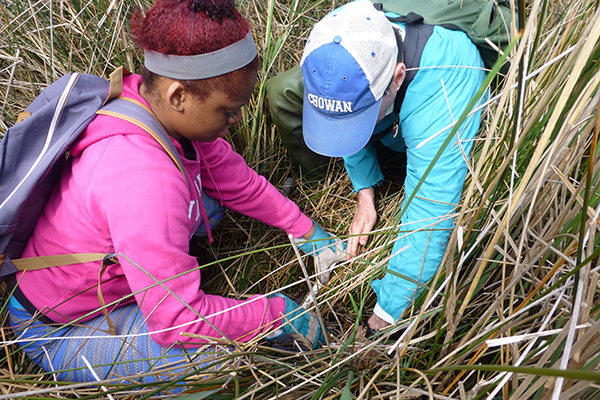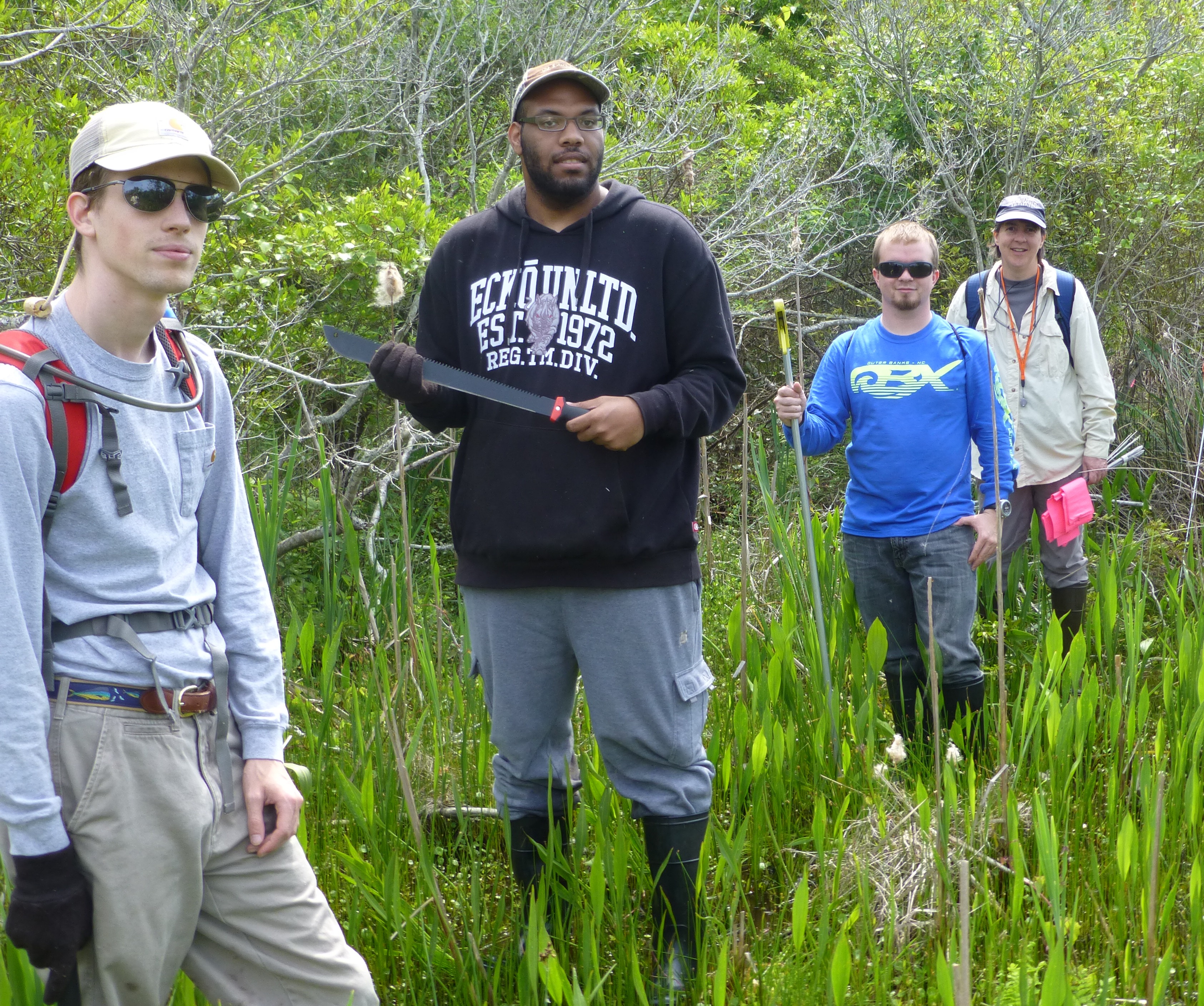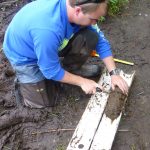
Student Neriah Howard assists researcher Bo Dame with collecting an above-ground biomass sample at Currituck Banks National Estuarine Research Reserve. All photos courtesy of the Chowan University Biology Department.
—
This project was featured in the Feb. 8 episode of UNC-TV’s North Carolina Science Now program. The segment, titled “Secrets of Currituck Sound,” can be accessed along with an article outlining the video and a short blog post from reporter Frank Graff on the origin of naming small bodies of water “sounds.”
Sitting outside a restaurant in Duck, North Carolina, a great partnership was expanded over a meal of local seafood in the fall of 2015.
Brandon Puckett and Scott Crocker of the North Carolina Coastal Reserve sought to better understand the impacts of sea-level rise at their Currituck Banks National Estuarine Research Reserve site in Corolla, and Currituck Sound in general. As faculty in the biology department at Chowan University, we were interested in the effects of sea-level rise, and had a desire to develop meaningful field experiences for undergraduates.
Our organizations have a history of working together on stewardship projects like alternative spring breaks, and an annual coastal field-ecology class. We agreed that adding a research component would be a great next step.

Chowan University students Kemper Sutton, Tyler Richards and Charles Blackburn learn to delineate the marsh-swamp boundary at Pine Island Sanctuary with wetland ecologist Heather McGuire.
Together with Robbie Fearn, director of Audubon’s Pine Island Sanctuary in Corolla, the headquarters for much of our work on the Outer Banks, we developed a grant proposal to fill information gaps for the reserve and sanctuary, while providing coastal-research opportunities for our students.
In spring 2016, our project was selected as part of the first round of the N.C. Community Collaborative Research Grant Program. The funding is provided by North Carolina Sea Grant, in partnership with the William R. Kenan Jr. Institute for Engineering, Technology and Science based at North Carolina State University.
According to the U.S. Army Corps of Engineers, Currituck Sound is losing over 70 acres of marsh each year, mostly due to erosion. This is believed to contribute to poor water quality and adverse impacts to submerged aquatic vegetation. Increased water levels associated with sea-level rise — a byproduct of rising waters and land subsidence — will only worsen the problem.
In 2014, Fearn and Audubon North Carolina helped organize the Alliance to Restore Currituck Sound with plans to pursue funds for marsh restoration. Through the Coastal Reserve, Puckett conducts several long-term monitoring efforts at their Currituck Banks site to help understand marsh resilience to sea-level rise. Our two-part study will directly contribute to these and other efforts.

Senior environmental biology student Charles Blackburn cuts a sediment core from Currituck Banks National Estuarine Research Reserve.
One component of our study is to locate sound-side marshes at the reserve and sanctuary. Wetland boundaries are being mapped using a very precise global positioning system. The mapping data then are analyzed with a geographic information system — a computer system for capturing, displaying and analyzing data related to positions on the Earth’s surface.
A second component is quantifying and comparing two major marsh types in Currituck Sound: Spartina cynosuroides, known as big cordgrass, and Phragmites australis, or common reed. We measure variables that contribute to marsh elevation change, including above-ground biomass of leaves, shoots and flowering parts; below-ground biomass of roots and rhizomes; decomposition or the rate of biomass breakdown; and sediment accretion — the accumulation of fine sediments.
These variables determine whether a marsh maintains its elevation with rising sea level or becomes inundated and drowns. Biomass accumulation, above and below ground, and sediment accretion contribute to increases in marsh elevation, while decomposition and sediment erosion result in decreases. The vegetation analyses will help prioritize sites for marsh restoration and aid in developing metrics to measure restoration success.
Managers also will need to make informed decisions on whether, and where, to encourage wetlands. Our maps will provide information on the areas most vulnerable to erosion and contribute to decisions regarding shoreline stabilization projects, such as the establishment of living shorelines. Study results also may be used in planning for marsh migration corridors into maritime forest swamps and uplands.
Undergraduates from Chowan University participate in all the project’s field and lab activities.
Our annual field ecology class was tasked with project setup and initial sampling. Students learned about coastal-barrier ecosystems and processes, climate change, sea-level rise and habitat response, and habitat mapping. They also constructed litterbags for measuring decomposition, and PVC quadrats and cores for collecting biomass. Classes in the field mapped wetlands, collected initial biomass samples, deployed litterbags and established feldspar plots for measuring sediment accretion.

Tyler Richards sorts different species from a vegetation sample as part of his undergraduate capstone project.
Three work-study students assist with sample analysis in the lab. Two senior environmental biology students, Charles Blackburn and Tyler Richards, are pursuing undergraduate capstone projects that assume responsibility for part of the overall study. They are examining differences in above- and below-ground biomass between marshes dominated by big cordgrass and common reed.
Our research project and results will be featured in displays at the reserve and sanctuary starting in summer 2017. These kiosks, located along popular trails, will give an overview of our project, along with background information on climate change and sea-level rise.
Due to the long timescale of natural processes, our project will not fully answer our fundamental research questions: “Can Currituck Sound wetlands accrete vertically and keep pace with rising seas, and how will wetland areas change?” However, our project will increase understanding in a region where data are limited.
Moreover, this project has laid a foundation for future collaborations, most likely beginning back where we started — with seafood and in good company.
James “Bo” Dame teaches biology and physical sciences at Chowan University in Murfreesboro. Dame has over 10 years experience in public lands management and environmental policy, including work as the northern sites manager for the North Carolina Coastal Reserve. Heather McGuire, biology department chair at Chowan, is a wetland ecologist and wildlife biologist with experience in conservation and management of rare and endangered populations.